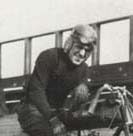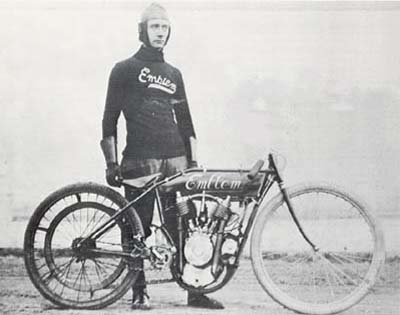by Daniel K. Statnekov |
| ©1998 - 2006 Daniel K. Statnekov |
|
Although 1914 was notable as the year of emergence for Harley-Davidson's
factory-supported racing efforts, it was also a year that witnessed the
Indian and Excelsior factory team's continuing struggle for dominance on
the race track.
Whereas the Excelsior twin racer was powered by a modified race-version of the motor that they sold to the public, the Indian 8-valve was a specially designed, thoroughbred race engine, designated for track use alone. As the originator of the special 8-valve motor, Hedstrom's departure from Indian had placed the Springfield company at a disadvantage as far as being able to benefit from his on-going expertise. On the other hand, Schwinn's well-staffed engineering department continued to update and fine-tune their original motor design. During the 1914 season, the Excelsior twin proved equal to the 8-valve Indian in numerous contests. Bob Perry, who had emerged during the previous year as one of Excelsior's top riders, won a close battle for the 5-mile National Championship at Sacramento, defeating his former teammate, Charles "Fearless" Balke, who had caused the fatal DeRosier accident and then defected to Indian. The following month Indian turned the tables on Excelsior with Balke winning a 5-mile pro event at Philadelphia. And so it went throughout the early part of the year with Excelsior and Indian see-sawing back and forth from one race meet to the next. On June 8, 1914, Charles Balke's career as a member of the Indian team ended when he was killed at a Chicago one-mile dirt track. The accident was described in the press as follows: |
With several other racers Balke started to circle the track
by way of tuning up a new 8-valve Indian. Balke's companions
were leading and such a cloud of dust was thrown up that the
little Californian did not see a horse-drawn roller which was
traveling around the track near the rail. He struck the roller
full-tilt in the rear and fractured his skull.
However that may be, Balke and his companions certainly didn't know the location of the roller and it seemed safe to assume that no warning was issued to them. The three or four riders with Balke saw the roller barely in time to turn out. One rider who was close to Balke on the outside of the track missed the roller by a hair's-breath, but Balke, hugging the rail, never had a chance.
|
|
1914 ended with Indian's Lee Taylor winning the important 300-mile
Savannah road race in November. In addition to Glen Boyd's
victory at Dodge City in July, the Springfield company was able to
advertise that for the 2nd year in a row an Indian-mounted rider had
won the treacherous San Diego to Phoenix desert race.
Harley-Davidson garnered valuable publicity when two riders on Milwaukee machines slogged through Arizona's near-impassable "Death-Trail," to place 2nd and 3rd in the popularly followed event. |
|
|
|
|
|
Webmaster: daniels@statnekov.com |
Page installed: Nov. 15, 1996 Page revised: June 28, 2003 |


